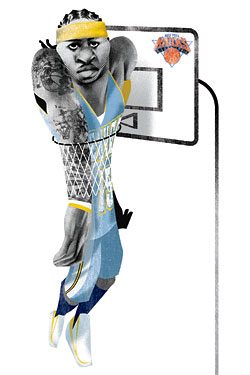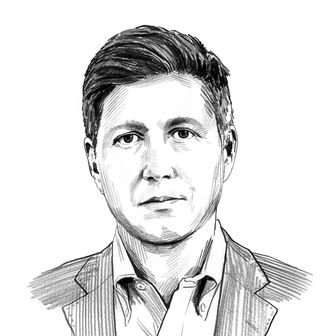
Illustration by André Carrilho
One year ago next week, the debate raging on our city’s back pages was whether the New York Knicks should sign Allen Iverson. This was mostly because we were all pretty bored. The team, in Year Two of its Fumigate the Isiah Era Project, was lousy and dull, 2-9, listless, and wretched to watch. That was part of the plan; last year’s Knicks roster was full of expiring contracts just serving out the rest of their sentences. Winning wasn’t the point; it almost would have gotten in the way.
Which is why Iverson, who had sulked his way out of Memphis and was well en route to sulking his way out of the NBA, became such a local curiosity. If the Knicks were going to lose, shouldn’t they lose with the flair of one of the league’s most marketable and thrilling players of all time? What did they have to lose? Give us something.
The Knicks, to the dismay of some fans, demurred, citing the team’s long-term interests. “With the development of some of our young guys and with Gallo [Danilo Gallinari] and Wilson [Chandler] and Toney Douglas,” coach Mike D’Antoni said at the time, “we just didn’t think right now we wanted to have that dominant force on the team.” On one hand, this was a polite way of saying, “Iverson’s a crazy person,” but the underlying message was, “We have a plan here. Let us stick to it.” Signing Iverson would have been an admission that the plan wasn’t working, that the Knicks were on par with the Grizzlies, bringing in a guy just because he’d help out at the turnstiles. Stunting the growth of young players, turning them into bit players in the Iverson Odyssey, would not have been the move of a confident organization. Signing Iverson was something Isiah Thomas would have done.
The plan hasn’t worked exactly as D’Antoni and team president Donnie Walsh drew it up—unless LeBron James is playing at the Garden right now, and someone just forgot to tell me—but they remain committed to it. The Knicks are amassing assets, and they are hanging on to them. This matters. And it matters more, really, than wins and losses. Which is good, because so far, in this season of Amar’e Stoudemire and the rediscovery of hope, there have been more of the latter than the former. That doesn’t mean the plan isn’t working. It certainly doesn’t mean it’s time to panic. Nor does it mean the Knicks should dump everything to trade for Denver’s Carmelo Anthony, however loudly the tabloids call for it or how tantalizing the prospect appears.
The irony of the first ten games of the New New Knicks is that their strengths are the exact opposite of what they were supposed to be. For all the excitement of D’Antoni’s “Seven Seconds or Less” quick-draw, scream-down-the-court-on-the-fast-break offense, the Knicks have looked confused and bewildered when they have the ball. Stoudemire is still waiting for his first superstar breakout game; he has shown surprising passivity in the lane and is turning the ball over at an alarming rate. New guard Raymond Felton has been a lovely improvement at the point, but he seems frustrated with his teammates’ inability to get in the flow of the offense and, specifically, his inability to get the pick-and-roll to work with Stoudemire. He has a perpetual “Hey, I thought this was going to be the easy part” look on his face. Douglas and Chandler have been better than advertised, but nothing is quite meshing. In D’Antoni’s third season as Knicks coach, we are still waiting for the offensive laser-light show we were promised.
But the Knicks are staying in games because of a shockingly strong defense, using their length and tenacity to take advantage of individual matchups. The Knicks are oddly fun to watch on the defensive end; they are among the NBA leaders in blocks and in steals. It makes them as entertaining as they are erratic; this is a team of young players still figuring out their abilities and how to interact with those of their teammates. The first half of their first game—a win over the Raptors—was a glittering example of what this could all be, a high-energy, hawking defense and a layup line of dunks in transition. The Knicks haven’t played as good a half since. This is a work in progress. But it’s a fun one. The energy at the Garden in the season’s first fortnight is the best it’s been in five years. This is a likable team, even when they’re losing.
Of course, that was part of the plan as well. The inconsistency—blistering wins over the Bulls and Wizards, followed immediately by sluggish losses to the 76ers and Bucks—was to be expected. The Knicks have six exciting young players who are improving with every game—Gallinari, Douglas, Chandler, Anthony Randolph, Timofey Mozgov, and breakthrough rookie Landry Fields—which is exactly six more than they’ve had at almost any point in the past decade. (Considering how many first-round picks Isiah traded away, this is rather amazing.) In the past, those players would have been traded away for past-their-prime stars in an ill-fated, undignified, quixotic stagger toward elusive postseason dreams. Now they’re here, and they’re ours. The Knicks have gone from one of the oldest, most slothful teams in the NBA to one of the youngest and most spry. The growing pains are sort of the point.
But just as Isiah keeps popping up to remind us he’s immortal—his interview earlier this month with ESPN.com’s Ian O’Connor, in which he claimed he was planning on returning to the team and defended his comically incompetent Knicks tenure with the tenacity of the Iraqi information minister, sending shivers down any Knicks fan’s spine—the old itches are coming back. With the LeBron/Wade/Bosh trio in Miami revolutionizing the notion of roster construction into a sort of Super Friends League of Justice, it’s starting to look like the Knicks have more patience than the men and women who write about them. Now that the Knicks have compiled all this developing talent, people want them to get rid of it. Everyone wants the Knicks to flip this house.
The object of affection is, of course, Carmelo Anthony, the disgruntled Denver Nuggets swingman who has openly stated that he wants to be traded. More specifically, he has said he wants to come here. (One of the people who claims Anthony talked to him about this is Isiah, of course.) In many ways, Anthony is a perfect fit. He’s an East Coast guy, born in Red Hook, and he’s the type of superstar scorer who salivates over playing in D’Antoni’s offense. (Even if we haven’t really seen that offense since Phoenix.) He’s also close friends with Stoudemire, whom he’s desperate to play with. And he’s with an organization that might even be more dysfunctional than the Knicks, if that’s even possible.
More to the point: He wants to get paid before it’s too late. At the end of this season, the NBA’s Collective Bargaining Agreement expires, and it’s possible (likely, even) that the max salary for superstars like Anthony will be lowered. So Anthony wants to be traded and have his contract extended while he still can. Obviously, a player of Anthony’s caliber—it’s worth noting that as good as he is, he’s not at the level of a LeBron or Wade or even Kevin Durant—is going to have plenty of suitors, the most rabid of which has been New Jersey, with its Russian-billionaire owner eager to steal some market share before the Nets move to Brooklyn. New Jersey makes a lot of sense, with its young talent, tradable assets, and deep pockets, but there’s one major problem: Anthony doesn’t want to play there. If he did, he would be there already. It’s clear he wants to come here. Following the LeBron/Wade/Bosh model, his plan is to come here with Stoudemire and persuade fellow pal Chris Paul to join up, building a triumvirate that would challenge the Heat for the next decade.
The Nuggets aren’t yet convinced that the Knicks have enough to trade for Anthony, but come February, at the trading deadline, when the Nuggets will have no choice but to make a move lest they risk losing Anthony for nothing, they may change their minds. By then, the Knicks’ six youngsters will likely be more attractive as well, as long as they keep progressing. And hey, who doesn’t like the idea of Anthony, Stoudemire, and Paul together?
But trading for Anthony, now or this February, would be a mistake. What the Knicks are building here is interesting because it can only appreciate in value. The Knicks would be making an Isiah move. For the first time in recent memory, the Knicks hold all the cards. Anthony wants to come here more quickly than the Knicks need him to. If they want, they can call his bluff: If he truly wants to be a Knick as much as he claims, he’ll sign in the off-season, no matter what the Nuggets do in February. After all, that’s what LeBron and Bosh did in Miami. Right now, Anthony wants what those two had without their sacrifice—his super-team and the maximum contract. The Knicks have built up enough cap space, through the excavation of the past two seasons, that they can afford to bring him in and keep their current talent on hand, which will make it easier for them to bring in Paul (or Utah’s Deron Williams, if they so desire) once Anthony comes here. And they’ll have better players to surround all of them. If he really does want to come here, he will; otherwise, hey, Carmelo, there’s Jersey, right over there. As great as Anthony is, surrounding him and Stoudemire with spare parts is not a recipe for a championship. Waiting, remaining patient, keeping Gallinari and Randolph and Chandler and seeing what happens, very well might be.
The Knicks have become a likable, exciting team on the way up by not making rash moves, by not pulling an Isiah and just bringing in whoever the hot name happens to be that moment. They have resisted quick fixes and hasty judgments. They are in the process of building something fascinating. We should let them do it. We’ve waited this long—what’s another year? It’s time to take a deep breath, relax, as athletes are taught to do, and let the game come to us. The Knicks are, finally, in a position of power. They must use the power wisely by not using it all.
You can write to Leitch at will.leitch@nymag.com.
